A Tale of Two Orphans in a War-Ridden Country: The Tragedy of War in Grave of the Fireflies
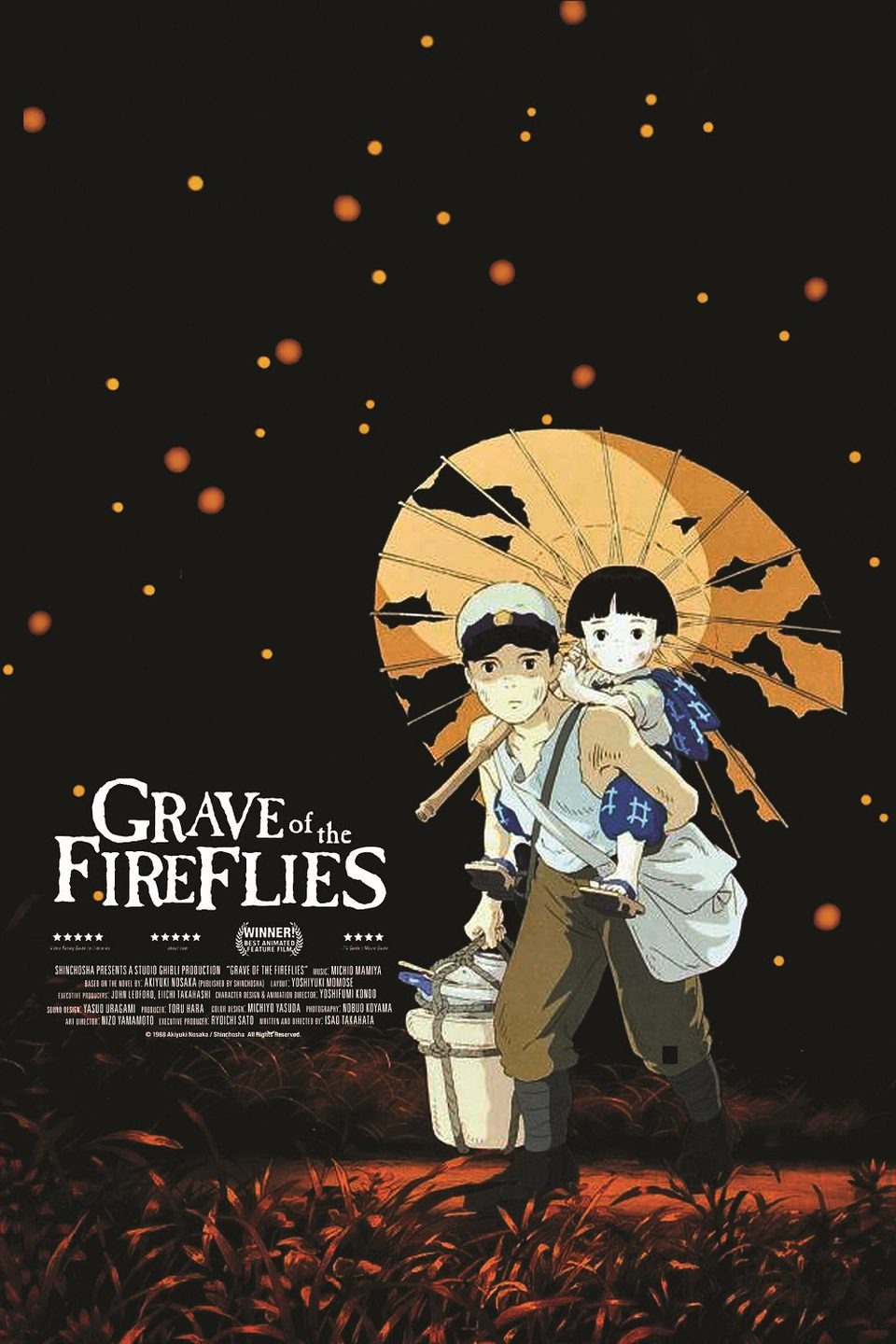
Grave of the Fireflies, directed by Isao Takahata, is an animated film that was released in Japan in 1988, but did not make it to the US until it’s VHS release in 1993. The film follows two recently orphaned siblings, Seita and Setsuko, as they attempt to survive in Kobe, Japan, during the last few months of WWII. In this beautifully animated film, it shows the tragedy of war and how it affects the people of the country at war.
The movie starts with showing a very sick Seita in a train station. He falls over and the narrator of the film states that he died on September 21, 1945. Janitors come to clean up his body, one of them finding a candy tin that was on Seita’s person. They throw it out into the field and when it hits the ground, it is revealed that the tin was filled with ashes and pieces of bone. The scene is tinted in a red light and reveals the spirit of Setsuko. She sees the body of her brother, tries to run to only to be stopped by the spirit of her brother, and they are reunited at last.
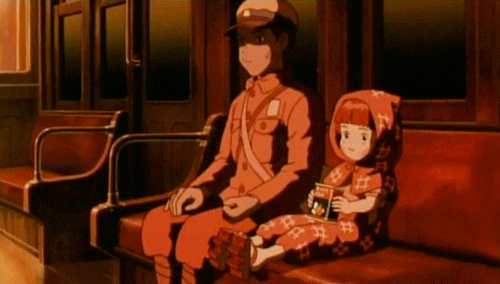
This is just within five minutes of the movie starting. The audience already knows what is going to happen to the main characters of this story, that they will die no matter what. Setting up the film to “retrace how the two of them reached their moments of death” (Goldberg 39). Yet even though the audience knows the fate of these children, they still want to know how they got to that point. The movie starts and explains what life was like for Seita and Setsuko before the war. They lived with their mother and their father. Seita was the oldest sibling, while Setsuko was the youngest. However, when the war started, their father went off to join the fight. Without their father, Seita, Setsuko, and their mother were left behind in Kobe.
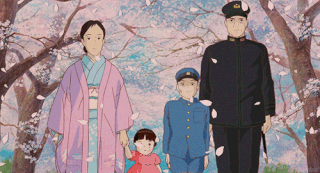
The family rarely heard from their father during the war, so it was just the three of them. After the opening scene, the movie takes the audience back to a few months earlier, before Seita’s death. It shows Seita, Setsuko, and their mother preparing to leave their home before an air raid. Their mother tells the children to go on ahead of her to the bomb shelter, she would catch up. So, the children set off to the shelter when the air raid happens.
The scene is a very graphic scene, especially since this film was advertised as a kid’s film (it was even shown right before My Neighbor Totoro). The scene showed the town burning, the town’s folk running in fear, and showed the dead bodies of soldiers. It also clearly highlights the terror of Seita and Setsuko as they run through the town. Seita is terrified and worried that he won’t be able to protect his sister. Setsuko is terrified by everything going on, since she is too young to understand why this is happening. Lucky for them, they were able to escape the air raid unharmed. So, they headed to the town shelter where the rest of the town was. It was there that they learned that their mother was not as lucky as them. Their mother was caught up in the air raid and was covered in severe third-degree burns. She succumbed to her injuries, leaving Seita and Setsuko by themselves.

The scene is another severely graphic scene because it shows the mother’s burned body, covered in gauze, but still able to see how horribly disfigured it is. There are flies and maggots surrounding the body, showing how awful the conditions of the shelter are. The scene also shows how callous the townsfolk are with the dead bodies, since there were so many. The town folks could not bring themselves to care about every lost life. The appalling living conditions and the lack of caring, shows how the war is taking its toll. With their mother gone, this leaves Seita and Setsuko all alone. This left Seita in charge of his little sister. They go off to live with a distant relative, who eventually grows resentful of them after food becomes scarce. This resentment makes the two siblings decide to go off on their own.
The two siblings take shelter in an abandoned bomb shelter on the outskirts of town. They are unable to afford anything besides food, so they use fireflies to give their new home some light at night. Even though these kids have been put through hell, the moments they share in the shelter, such as releasing the fireflies, shows the innocence of these two. They’re still kids, who find enjoyment in the littlest things even when their lives are awful now. The audience sees those moments throughout the movie, those moments of joy and innocence that only children can have. Which can make the audience forget that the movie is taking place in the past. The audience loves seeing the children happy and wanting nothing but the best for them, only to realize that their fates have already been decided.
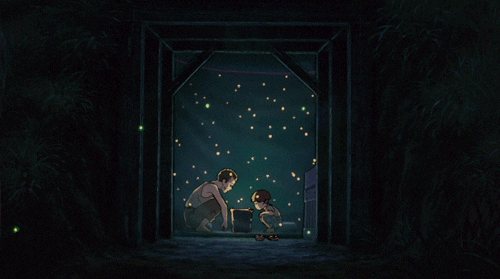
Which is why the most memorable line from this movie is “why do fireflies have to die so soon?” (Takahata). The line is said by Setsuko, who is crying over the death of the fireflies that brought their shelter light the night before. The line perfectly describes the loss of life that happens in the movie, especially Seita and Setsuko’s lives. Seita is fourteen at the beginning of the movie and dies at fourteen, Setsuko is four at the beginning of the movie and dies at four. Both of their lives come to a tragic end and cut way too short, just like fireflies.
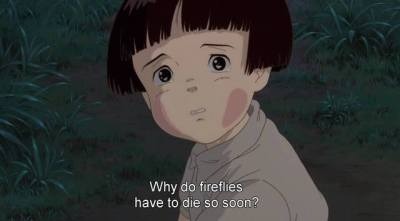
Which brings me to the most heartbreaking scene of the entire movie, the death of Setsuko. Throughout the movie, Setsuko’s health has been declining due to malnutrition. Seita does all he can to ensure her health. He takes out the last of their savings from their mother’s bank account, so he can buy food for them. At the bank he learns that Japan has surrendered. He also learns that his father is probably dead because it is said that most of the Japanese Navy has been sunk. With that news hanging over him, he hurries to Setsuko with all the food he has just bought. Setsuko is lying down in the shelter, hallucinating from hunger and sucking on a marble that she thought was candy. Seita is quick to remove the marble out of her mouth and tries to feed her some watermelon as a snack. While he is preparing it for her, Setsuko offers Seita a “rice ball” that she made, which is just a rock. He rushes to feed her the watermelon he cut up and tells her to sit tight as he prepares a meal for her. As he goes off to cook for them, Setsuko takes a nap and never wakes up.
The scene cuts to Seita holding Setsuko’s body, his eyes looking dead as the rain pours outside of their makeshift home. Seita cremates his sister, puts her ashes into her candy tin, and carries her with him. The audience never sees what happens between Setsuko’s death and Seita’s death. The audience can assume from that, that Seita’s actual death can be seen as his final death. While the death of Setsuko was Seita’s first death, showing that he stopped living once he lost Setsuko. Which is why he ended up at the train station at death’s doorstep. Seita had given up and saw no point in living without Setsuko. Seita only had Setsuko for the longest time, so losing her must have pushed him past his breaking point.
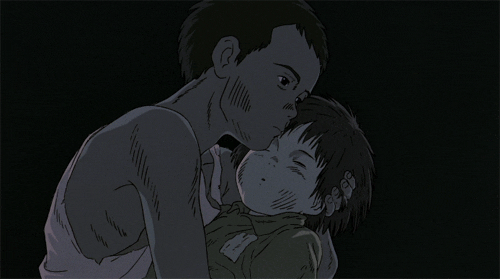
The movie ends with Seita and Setsuko’s spirits sitting on a hilltop overlooking the skyline of present-day Kobe, while fireflies surround the siblings. After such a tragic movie, the audience (as they attempt to wipe away the tears from their eyes) could find a little comfort in knowing that the two siblings are finally at peace. The film really highlights the tragedy of war and gives a spotlight on those who lose everything because of war. Some stories end up forgotten though, stories like Seita and Setsuko’s, they just get clumped together with all the other casualties of war. This movie is a work of art that was not afraid to show the tragedy that war brings, especially for the losing side of a war. That’s why it is important to watch this film because the losing side of a war rarely gets to tell the story of what the people of the losing side have lost along the way. The article, “Memory and Forgetting: Examining the Treatment of Traumatic Historical Memory in Grave of the Fireflies and The Wind Rises,” says it best about this film:
It would be difficult to imagine a more poignant and hard-hitting account of the tragedy and cruelty of war in either conventional cinema or animated formats, and certainly the excruciatingly slow demise of the doomed brother and sister towards a pitiful end makes it a heartrending tour de force.
Grave of the Fireflies is a tragic film that highlights the tragedy of war, but also highlights the lengths that humans will go to survive. Some of them strive to survive for only themselves, but then there are some who strive to survive for others around them. Seita strives to survive for his sister and to ensure that she would have a happy life. Which was shown in the little moments of happiness and innocence that the siblings had with each other. In the end, those moments made the movie even more heartbreaking, because they were just kids after all.
Work Cited
Goldberg, Wendy. “Transcending the Victim’s History: Takahata Isao’s Grave of the Fireflies.” Mechademia, vol. 4, no. 1, 2009, pp. 39–52, doi:10.1353/mec.0.0030.
Swale, Alistair. “Memory and Forgetting: Examining the Treatment of Traumatic Historical Memory in Grave of the Fireflies and The Wind Rises.” Japan Forum, vol. 29, no. 4, Routledge, Oct. 2017, pp. 518–36, doi:10.1080/09555803.2017.1321570.
Takahata, Isao, director. Grave of the Fireflies. Studio Ghibli , 1988.
0 Comments Add a Comment?